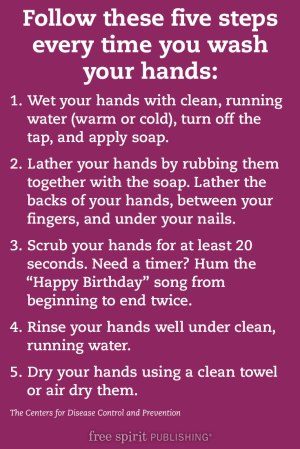Hurray, it’s the holiday season!
Uh-oh, it’s also cold and flu season.
Parties, travel, and gatherings are all part of holiday fun, but time spent with others during cold and flu season means that you and your children are more likely to get sick. What are you supposed to do—hide out and avoid the crowds? Impossible. There are ways to reduce the risk of getting viruses, though. It all starts with the hands.
Your hands are busy all day long, and they touch so many different surfaces: railings, countertops, handles, money, credit cards, computer keyboards, the steering wheel, the remote control. Did you know that flu viruses can survive on a hard surface for up to 24 hours? As a parent, you probably spend part of your day changing diapers, helping your child in the bathroom, wiping noses, or cleaning up spills and messy faces too. In other words, your hands are in constant contact with a variety of germs through touch. If you then put a finger in your mouth, nose, or eye, you’ve introduced germs into an environment where they take hold and spread.
To reduce your exposure to viruses and bacteria, wash your hands often—the right way. A recent study by the US Department of Agriculture determined that people fail to correctly wash their hands 97 percent of the time. The most common mistake? Not washing hands long enough to kill germs. Looks like many adults need a review on handwashing so we can help our kids do it right! The following CDC guidelines for handwashing can help.
 Follow these five steps every time:
Follow these five steps every time:
- Wet your hands with clean running water (warm or cold), turn off the tap, and apply soap.
- Lather your hands by rubbing them together with the soap. Lather the backs of your hands, between your fingers, and under your nails.
- Scrub your hands for at least 20 seconds. Need a timer? Hum the “Happy Birthday” song from beginning to end twice.
- Rinse your hands well under clean running water.
- Dry your hands using a clean towel or air dry them.
(From the Centers for Disease Control and Prevention)
Practice these handwashing techniques with your children as early as the toddler years. You may want to teach the phrase “Germs are not for sharing” as a reminder. As your children get older, check in to make sure they’ve remembered to follow the handwashing steps, especially before and after eating; after using the bathroom; after sneezing, coughing, or blowing their nose; and after touching a phone, computer, or tablet.
Despite all your preventive measures and good intentions, your child still may get sick with a cold or the flu. If possible, keep a child who is ill confined to a specific area of your home to avoid spreading the illness to others. Show children how to sneeze and cough into a tissue or their sleeve (not on each other or you). Keep surfaces clean by frequently wiping them down with cleansers or bleach.
Sick time isn’t any fun, but you can help your child pass the hours by doing quiet holiday-related activities—reading winter-themed stories, making cards for loved ones, wrapping presents, and watching holiday movies. And don’t forget: If you’re the one who’s sick, stay home. You may have many tasks and people to take care of during the season, but you need time for yourself too.
Here’s to staying healthy and enjoying the holidays with loved ones . . . cheers!
“Invite Guests—Not Germs—to Your Home During the Holidays” originally appeared at freespiritpublishingblog.com. Copyright © 2020 by Free Spirit Publishing. All rights reserved.

